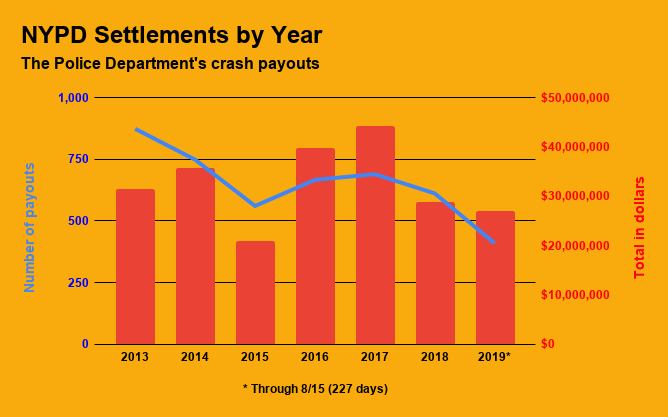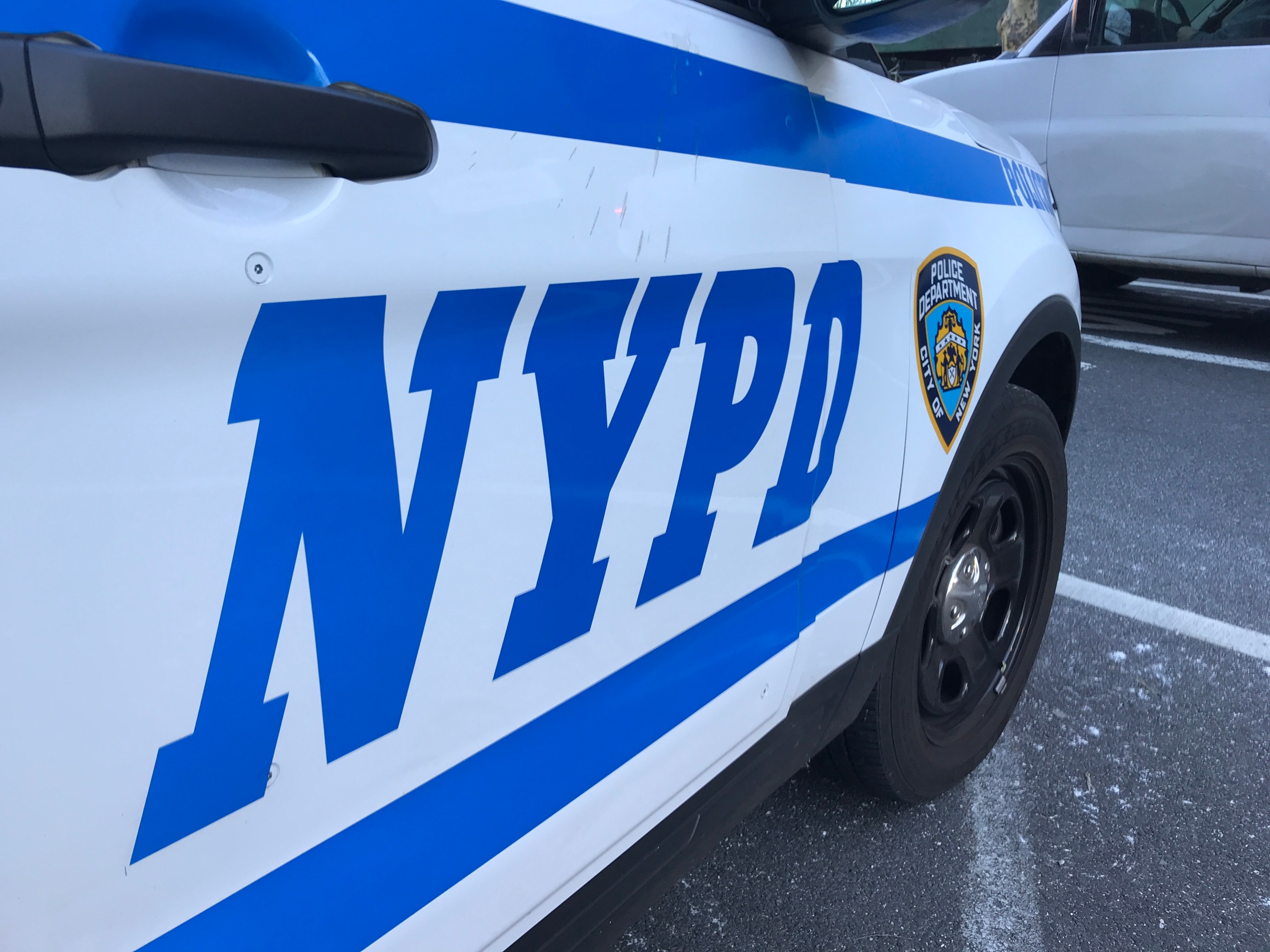A notice of claim filed last week seeking $20 million from the city after a speeding cop hit and killed a young woman in the Bronx raises questions anew about police procedures in vehicle pursuits, and how cops hardly ever face any real punishment after injuring, and even killing, victims, attorneys say.
The city could be forced to pay out $20 million to the family of 20-year-old Sofia Gomez Aguilon, who was killed by Police Officer Ceasar Munoz as he sped at 60 miles-per-hour through a red light on Pelham Parkway near Wallace Avenue on Oct. 5 — driving so recklessly that he should be held responsible for Gomez Aguilon’s death, according to her family’s attorney.
“The video clearly shows that the officer that struck Sofia was reckless,” said personal injury attorney Louis Grandelli. “The evidence demonstrates that the police vehicle sped through a red light at a high rate of speed at a busy intersection, and we hope that the city acknowledges the enormity of this tragedy.”
But the case only brings to light questions about the NYPD’s culture of driving recklessly with impunity, and the system that protects cops, despite the millions of dollars each year the city is forced to pay out to victims and families like Gomez Aguilon’s.
“Cops get immunity if they are involved in a crash,” said Dan Flanzig, who also represents victims of traffic violence.

As hard as it is to prosecute a driver for hitting and killing a pedestrian or cyclist, it’s even harder to go after one of New York’s Finest, in both civil and criminal court, according to Flanzig. Charging a cop requires a higher level of proof than a non-member of service because the state’s Vehicle and Traffic Law (statute 11-04a) affords emergency vehicles a certain leeway, he said.
“Emergency vehicles are granted pretty wide immunity under the law. The drivers’ operation has to rise to a level of recklessness, not just negligence, in a gross disregard for the safety of others. It’s a much higher standard than just regular negligence,” said Flanzig.
But Grandelli believes he can meet that standard in civil court, where he is seeking a pain-and-suffering settlement for Gomez Aguilon's family, since Munoz was both driving above the speed limit and went through a red light.
“If we can show two negligent acts, that’s reckless — here is speeding through a red light,” Grandelli said.
And what raises even more questions about the level of protection afforded to cops is the one they try to seek themselves by showing up en masse to the scene of fatal crashes involving their colleagues.
That evidence is right in the NYPD’s own files. An internal police document of the crash obtained by Streetsblog says that 15 investigators from NYPD’s Collision Investigation Squad showed up to the fatal crash — nine more than showed up to both a fatal hit-and-run on Linden Boulevard in Queens last Saturday, and to the scene of the fatal motorcyclist crash on Third Avenue in Sunset Park on Oct. 3 that left 31-year-old Clara Kang dead. It's also 11 more investigators than showed up after 35-year-old Sarah Pitts was killed in Williamsburg on Sept. 7, according to multiple police reports.
The significantly larger presence at the scene of the Bronx crash is notable given that CIS is so notoriously understaffed that last year the City Council wanted to increase its budget by $2 million so that the 26-member team could respond to more than just 5 percent of the 2,000-3,000 fatal and near-fatal crashes every year. The city’s top cop at the time, Police Commissioner James O’Neill, declined the additional money.
Both Flanzig and attorney Steve Vaccaro say it’s not uncommon for more investigators to show up to the scene of a crash involving a member of service because the city’s Internal Affairs Bureau must come, city-involved crashes generally tend to draw more attention and resources, and also because they want to protect their own by putting up a wall to the public.
“They’re showing up en masse to protect a member of service,” said Flanzig.
It’s a practice all too familiar to Flanzig, who is representing the family of 22-year-old Jack Koval, whom an off-duty cop hit and killed in Manhattan in 2016.
Police tried to blame Koval for his own death, saying he had “climbed over a divider and stepped into oncoming traffic.” Without any help from the city or the officers who were supposed to be investigating the case, Koval’s parents took matters into their own hands to clear their only child’s name.
And they did — it was ultimately revealed that the off-duty cop, Steven Oquendo, behind the wheel of a Dodge Charger, had struck and killed Koval at a likely high rate of speed while Koval was in the crosswalk.
Oquendo was never held criminally responsible, but a civil suit against Oquendo is pending, the family's attorney said.
“What I saw with Jack, it was done in a manner to protect (the cop),” Flanzig said.
Like in the Koval case, cops initially tried to lie about what actually happened, saying at first that Munoz was only driving 30- to 40-miles-per-hour when he struck Gomez Aguilon, until NYPD Commissioner Dermot Shea admitted on NY1 last week that the officer was actually going much faster. Shea said Munoz had been pulled from patrol, and last Sunday, less than a week after Gomez was killed, Attorney General Letitia James announced her office was opening an investigation into the fatal crash.
BREAKING: @NewYorkStateAG opens investigation into the death of Sofia Gomez. She died after being struck by an @NYPDHighway officer responding to an incident on Monday. https://t.co/HvuhEF7kId pic.twitter.com/EOgZuqK8Wr
— Myles Miller (@MylesMill) October 11, 2020
But unlike in the Koval case, this time there’s video — which Grandelli says clearly shows Gomez Aguilon see the car come careening towards her, and attempt to get out of the way before freezing in fear, raising questions about why Munoz did not slow or stop before fatally hitting the young woman.
“It’s hard to imagine what possible excuse the officer could have for not seeing Sofia when he had a clear and unobstructed view of the intersection, and it’s evident she was able to see the vehicle,” Grandelli said.
Police claimed that Munoz was responding to a call of shots fired seven miles away — in Queens — when he hit Gomez Aguilon. This alleged incident, and the NYPD's response to it, could also come up in court. It should.
And while the state law allows cops to speed and go through red lights when responding to an emergency, the NYPD’s Patrol Guide for vehicle pursuits offers little more actual guidance — there’s no limitations on speed, or distance a cop can drive when responding to such a call. The only restrictions are that two-and-three-wheeled vehicles cannot engage in chases, and that any tactics used in an attempt to stop a vehicle are prohibited, like ramming, or abruptly cutting off the vehicle.
But Grandelli questioned the need for Munoz to speed along Pelham Parkway to respond to a crime that began in Queens, miles away from where he regularly patrols in the Bronx. As such, he is demanding the city hand over all related radio and computer transmissions related to the chase and response that led to the death of Gomez Aguilon.
The Oct. 5 Bronx crash at least the second fatal crash involving an NYPD patrol car this year.
On July 25, two cops in a marked NYPD squad car struck and killed 37-year-old motorcyclist Delroy Morris at the intersection of Metropolitan and Driggs avenues in Williamsburg.
Just as in Gomez’s case, the cops who hit Morris claimed they were also responding to a shooting that later turned out to be a false alarm, and that the vehicle’s lights and sirens were blaring. But witnesses told the Daily News that only the lights were on, not sirens.
The driver in that case, Officer Angelo Martino, has one complaint against him filed by a 37-year-old Hispanic man in February, 2019, which includes two substantiated allegations for abusing his power during a vehicle stop-and-frisk, according to a database by ProPublica.
And in the end, it's taxpayers who are always forced to pay the price — the city has had to pay out $228 million in settlements to victims of vehicle crashes involving the NYPD since 2013, through last August, Streetsblog reported.
The NYPD declined to comment.






